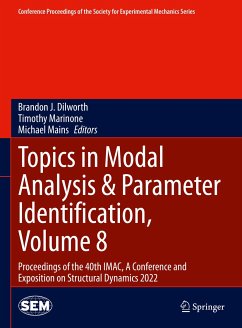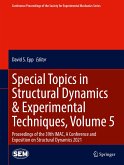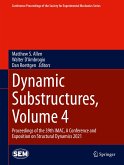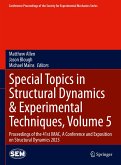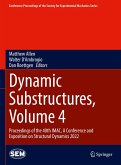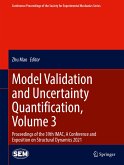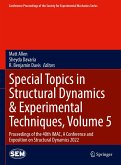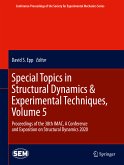Topics in Modal Analysis & Parameter Identification, Volume 8 (eBook, PDF)
Proceedings of the 40th IMAC, A Conference and Exposition on Structural Dynamics 2022
Redaktion: Dilworth, Brandon J.; Mains, Michael; Marinone, Timothy


Alle Infos zum eBook verschenken

Topics in Modal Analysis & Parameter Identification, Volume 8 (eBook, PDF)
Proceedings of the 40th IMAC, A Conference and Exposition on Structural Dynamics 2022
Redaktion: Dilworth, Brandon J.; Mains, Michael; Marinone, Timothy
- Format: PDF
- Merkliste
- Auf die Merkliste
- Bewerten Bewerten
- Teilen
- Produkt teilen
- Produkterinnerung
- Produkterinnerung

Hier können Sie sich einloggen

Bitte loggen Sie sich zunächst in Ihr Kundenkonto ein oder registrieren Sie sich bei bücher.de, um das eBook-Abo tolino select nutzen zu können.
Topics in Modal Analysis & Testing, Volume 8: Proceedings of the 40th IMAC, A Conference and Exposition on Structural Dynamics, 2022, the eighth volume of nine from the Conference, brings together contributions to this important area of research and engineering. The collection presents early findings and case studies on fundamental and applied aspects of Modal Analysis, including papers on:
Operational Modal & Modal Analysis Applications | Experimental Techniques | Modal Analysis, Measurements & Parameter Estimation | Modal Vectors & Modeling | Basics of Modal Analysis | Additive Manufacturing & Modal Testing of Printed Parts …mehr
- Geräte: PC
- ohne Kopierschutz
- eBook Hilfe
- Größe: 13.24MB
![Special Topics in Structural Dynamics & Experimental Techniques, Volume 5 (eBook, PDF) Special Topics in Structural Dynamics & Experimental Techniques, Volume 5 (eBook, PDF)]() Special Topics in Structural Dynamics & Experimental Techniques, Volume 5 (eBook, PDF)177,95 €
Special Topics in Structural Dynamics & Experimental Techniques, Volume 5 (eBook, PDF)177,95 €![Dynamic Substructures, Volume 4 (eBook, PDF) Dynamic Substructures, Volume 4 (eBook, PDF)]() Dynamic Substructures, Volume 4 (eBook, PDF)193,95 €
Dynamic Substructures, Volume 4 (eBook, PDF)193,95 €![Special Topics in Structural Dynamics & Experimental Techniques, Volume 5 (eBook, PDF) Special Topics in Structural Dynamics & Experimental Techniques, Volume 5 (eBook, PDF)]() Special Topics in Structural Dynamics & Experimental Techniques, Volume 5 (eBook, PDF)178,95 €
Special Topics in Structural Dynamics & Experimental Techniques, Volume 5 (eBook, PDF)178,95 €![Dynamic Substructures, Volume 4 (eBook, PDF) Dynamic Substructures, Volume 4 (eBook, PDF)]() Dynamic Substructures, Volume 4 (eBook, PDF)193,95 €
Dynamic Substructures, Volume 4 (eBook, PDF)193,95 €![Model Validation and Uncertainty Quantification, Volume 3 (eBook, PDF) Model Validation and Uncertainty Quantification, Volume 3 (eBook, PDF)]() Model Validation and Uncertainty Quantification, Volume 3 (eBook, PDF)177,95 €
Model Validation and Uncertainty Quantification, Volume 3 (eBook, PDF)177,95 €![Special Topics in Structural Dynamics & Experimental Techniques, Volume 5 (eBook, PDF) Special Topics in Structural Dynamics & Experimental Techniques, Volume 5 (eBook, PDF)]() Special Topics in Structural Dynamics & Experimental Techniques, Volume 5 (eBook, PDF)193,95 €
Special Topics in Structural Dynamics & Experimental Techniques, Volume 5 (eBook, PDF)193,95 €![Special Topics in Structural Dynamics & Experimental Techniques, Volume 5 (eBook, PDF) Special Topics in Structural Dynamics & Experimental Techniques, Volume 5 (eBook, PDF)]() Special Topics in Structural Dynamics & Experimental Techniques, Volume 5 (eBook, PDF)161,95 €
Special Topics in Structural Dynamics & Experimental Techniques, Volume 5 (eBook, PDF)161,95 €-
-
- -24%11
- Operational Modal & Modal Analysis Applications
- Experimental Techniques
- Modal Analysis, Measurements & Parameter Estimation
- Modal Vectors & Modeling
- Basics of Modal Analysis
- Additive Manufacturing & Modal Testing of Printed Parts
Dieser Download kann aus rechtlichen Gründen nur mit Rechnungsadresse in A, B, BG, CY, CZ, D, DK, EW, E, FIN, F, GR, HR, H, IRL, I, LT, L, LR, M, NL, PL, P, R, S, SLO, SK ausgeliefert werden.
- Produktdetails
- Verlag: Springer Nature Switzerland
- Seitenzahl: 179
- Erscheinungstermin: 3. August 2022
- Englisch
- ISBN-13: 9783031054457
- Artikelnr.: 64720420
- Verlag: Springer Nature Switzerland
- Seitenzahl: 179
- Erscheinungstermin: 3. August 2022
- Englisch
- ISBN-13: 9783031054457
- Artikelnr.: 64720420
- Herstellerkennzeichnung Die Herstellerinformationen sind derzeit nicht verfügbar.
